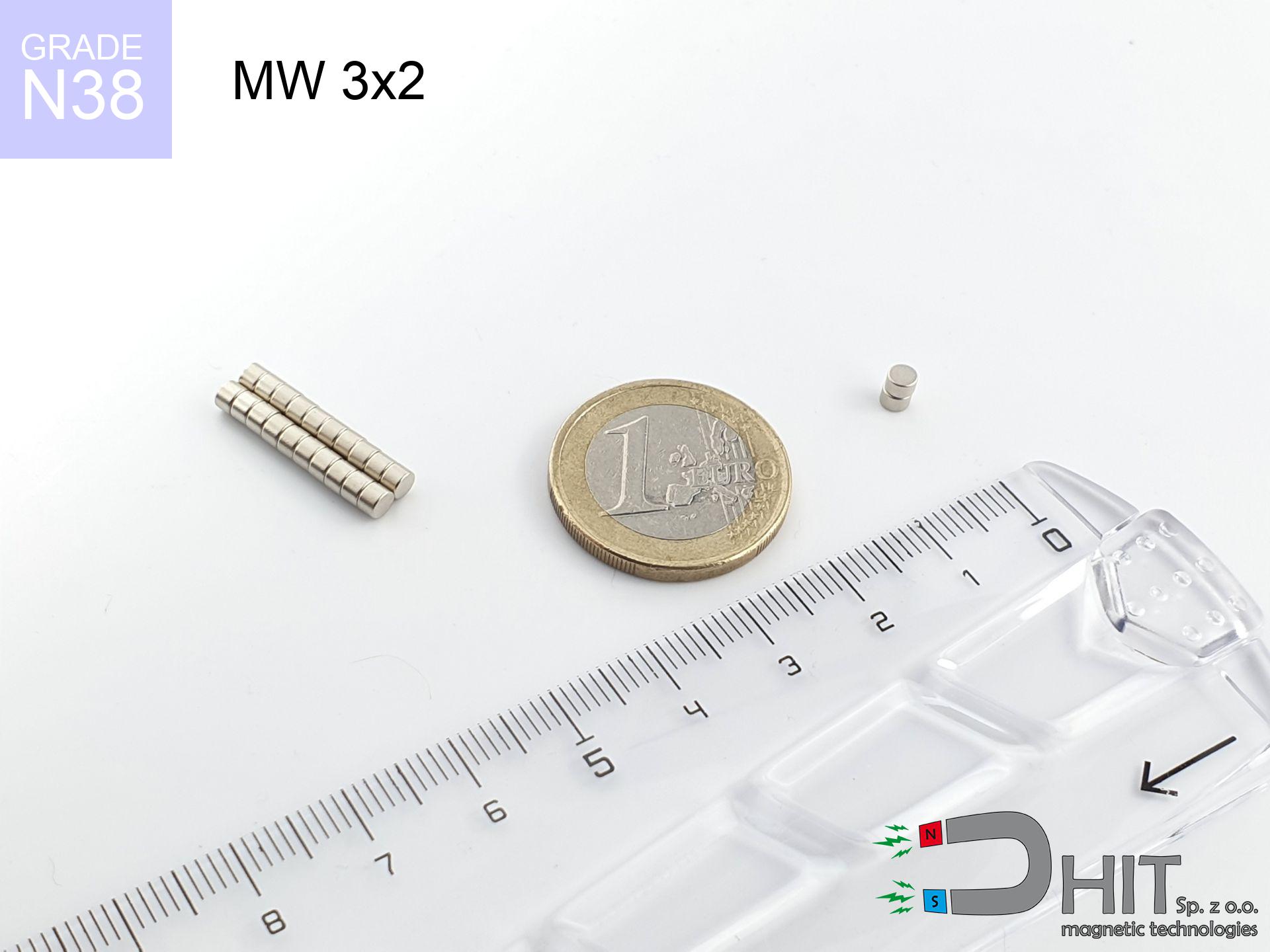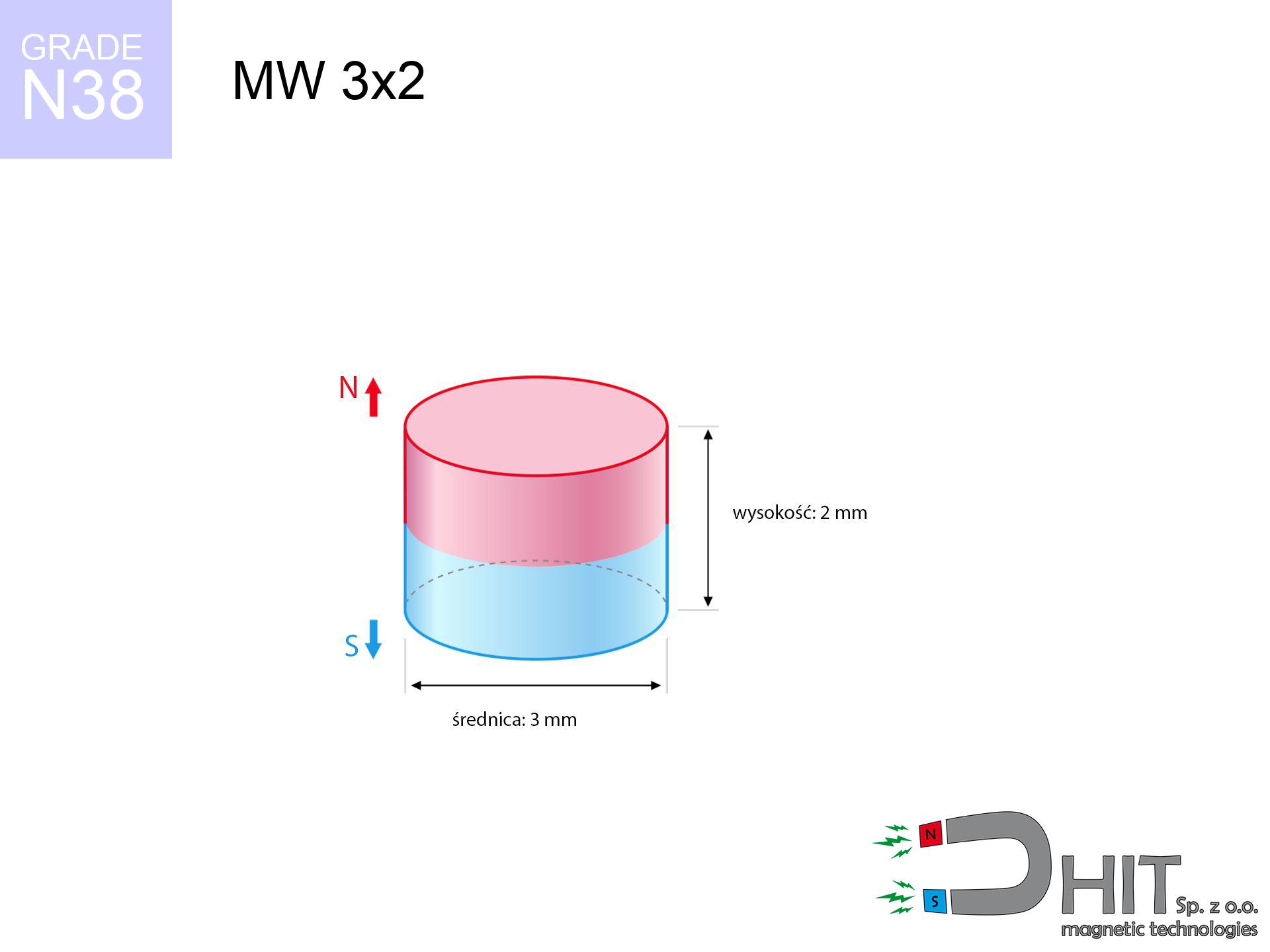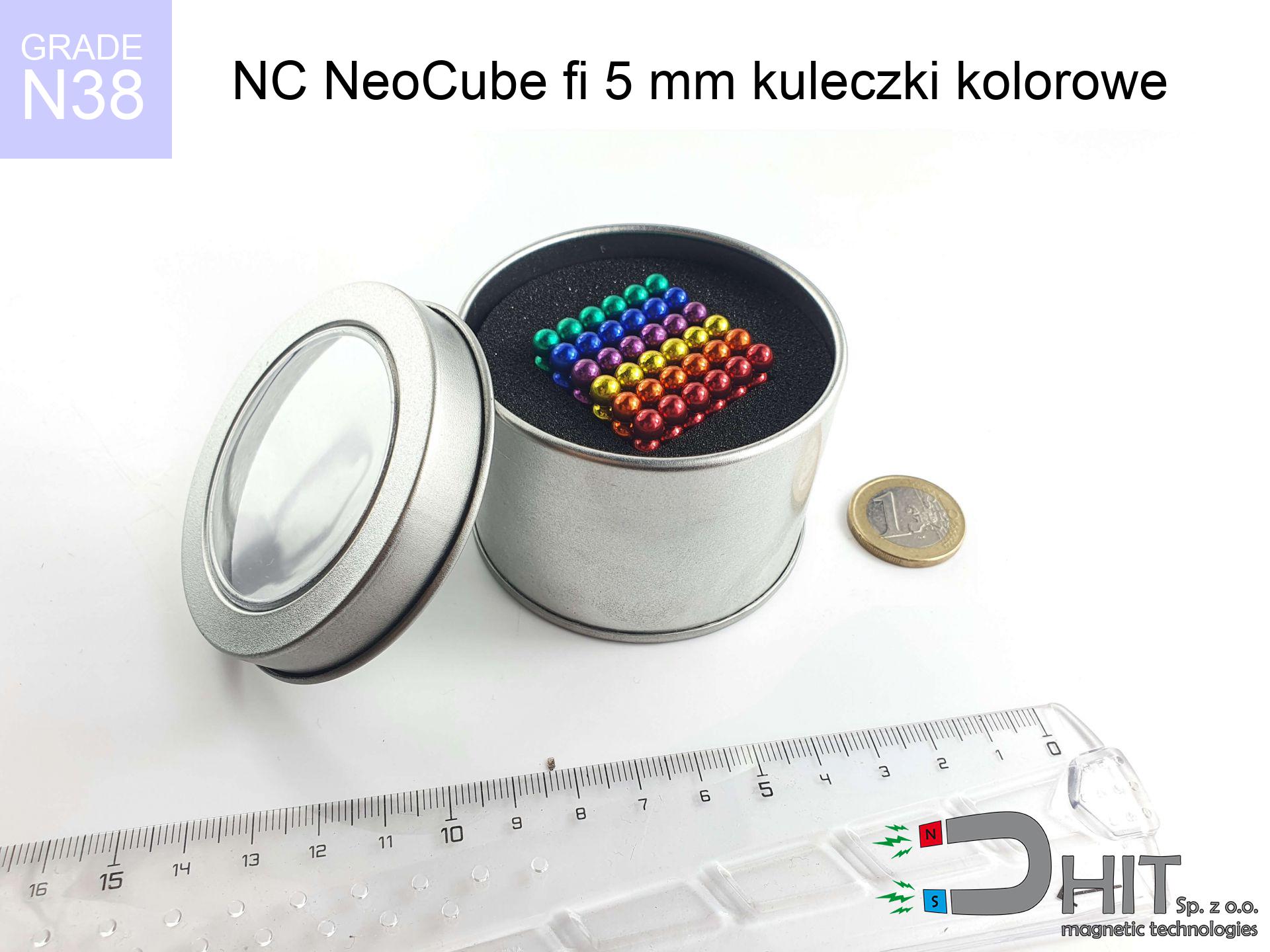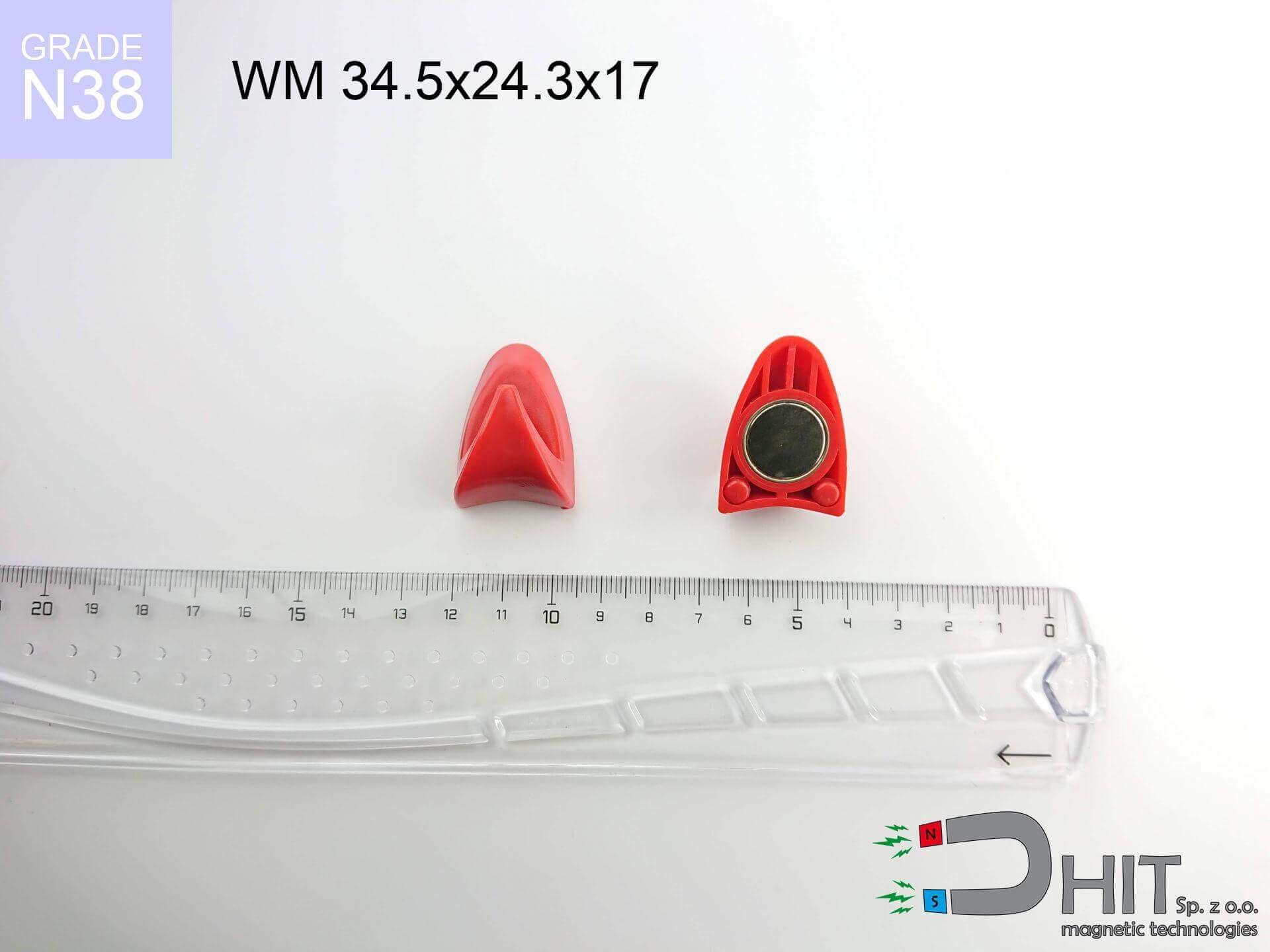MW 3x2 / N38 - neodymium magnet
cylindrical magnet
catalog number 010064
GTIN: 5906301810636
diameter Ø
3
mm [±0,1 mm]
height
2
mm [±0,1 mm]
magnetizing direction
↑ axial
capacity ~
0.33 kg / 3.24 N
magnetic induction ~
493.99 mT / 4,940 Gs
max. temperature
≤ 80
°C
catalog number 010064
GTIN: 5906301810636
diameter Ø
3 mm [±0,1 mm]
height
2 mm [±0,1 mm]
magnetizing direction
↑ axial
capacity ~
0.33 kg / 3.24 N
magnetic induction ~
493.99 mT / 4,940 Gs
max. temperature
≤ 80 °C
0.16 ZŁ gross price (including VAT) / pcs +
0.13 ZŁ net price + 23% VAT / pcs
bulk discounts:
need more quantity?Want a better price?
Call us tel: +48 22 499 98 98 or write through form on our website. You can check the strength as well as the shape of magnet in our magnetic mass calculator magnetic mass calculator
Orders placed by 2:00 PM will be shipped on the same business day.
Specification: cylindrical magnet 3x2 / N38 ↑ axial
Magnetic properties of the material N38
Physical properties of sintered neodymium magnets Nd2Fe14B
Moreover, although neodymium is part of the strongest magnets, they are susceptible to corrosion in humid environments. For this reason, they are coated with a thin layer of silver to increase their durability. It's worth noting that NdFeB neodymium magnets are about 13% lighter than SmCo magnets and, despite their power, easily break, which requires care during their handling. For this reason, any mechanical processing should be done before they are magnetized.
In terms of safety, there are many recommendations regarding the use of these magnets. They should not be used in acidic, basic, organic environments or in solvents, as well as in water or oil. Additionally, they can distort data on magnetic cards and hard drives, although data deletion using a neodymium magnet is not guaranteed.
In terms of properties in different environments, neodymium magnets are sensitive to corrosion, especially in humid conditions. Therefore, they are often coated with thin coatings, such as silver, to protect them from environmental factors and extend their lifespan. Temperatures exceeding 130°C can cause a reduction of their magnetic strength, although there are specific types of neodymium magnets that can withstand temperatures up to 230°C.
As for potential dangers, it is important to avoid using neodymium magnets in acidic environments, basic conditions, organic or solvent environments, unless they are properly protected. Additionally, their use is not recommended in wet conditions, oil, or in an environment containing hydrogen, as they may forfeit their magnetic strength.
List recommended items
Advantages as well as disadvantages of neodymium magnets NdFeB.
Apart from immense strength, neodymium magnets have the following advantages:
- They do not lose their strength (of the magnet). After about 10 years, their power decreases by only ~1% (theoretically),
- They protect against demagnetization caused by external magnetic field very well,
- In other words, thanks to the shiny coating of nickel, gold, or silver, the element acquires an aesthetic appearance,
- They exhibit extremely high magnetic induction on the surface of the magnet,
- Magnetic neodymium magnets are characterized by very high magnetic induction on the surface of the magnet and can operate (depending on the form) even at temperatures of 230°C or higher...
- The ability for precise shaping and customization to specific needs – neodymium magnets can be produced in many variants of shapes or sizes, which amplifies their universality in usage.
- Wide application in advanced technologically fields – are used in computer drives, electric motors, medical apparatus or very modern machines.
Disadvantages of neodymium magnets:
- They are prone to breaking as they are extremely fragile when subjected to a strong impact. If the magnets are exposed to impacts, we recommend using magnets in a steel housing. The steel housing in the form of a holder protects the magnet from impacts and also increases its overall strength,
- High temperatures can reduce the strength of neodymium magnets. Typically, after heating above 80°C, most of them experience a permanent loss in strength (although it is dependent on the shape and size). To prevent this, we offer special magnets marked with the symbol [AH], which are highly resistant to high temperatures. They can operate even at temperatures up to 230°C, making them an ideal solution for applications requiring high-temperature operation,
- Magnets exposed to a humid environment can corrode. Therefore, when using them outdoors, we recommend using waterproof magnets made of rubber, plastic, or other moisture-resistant materials,
- Limited ability to create threads or complex shapes in the magnet - the use of a housing is recommended - magnetic holder
- Potential hazard to health from tiny fragments of magnets can be dangerous, when accidentally ingested, which is crucial in the context of children's health. It's also worth noting that tiny parts of these devices are able to be problematic in medical diagnosis after entering the body.
Exercise Caution with Neodymium Magnets
Dust and powder from neodymium magnets are flammable.
Do not attempt to drill into neodymium magnets. Mechanical processing is also not recommended. Once crushed into fine powder or dust, this material becomes highly flammable.
Neodymium magnets should not be near people with pacemakers.
Neodymium magnets produce strong magnetic fields that can interfere with the operation of a heart pacemaker. Even if the magnetic field does not affect the device, it can damage its components or deactivate the entire device.
Neodymium magnets are primarily characterized by their significant internal force. They attract to each other, and any object that comes in their way will be affected.
Magnets will attract each other within a distance of several to about 10 cm from each other. Don't put your fingers in the path of magnet attraction, because a serious injury may occur. Magnets, depending on their size, are able even cut off a finger or there can be a significant pressure or a fracture.
Neodymium magnets are especially fragile, which leads to their breakage.
Neodymium magnets are highly delicate, and by joining them in an uncontrolled manner, they will break. Neodymium magnets are made of metal and coated with a shiny nickel surface, but they are not as hard as steel. At the moment of collision between the magnets, small metal fragments can be dispersed in different directions.
Neodymium magnets can demagnetize at high temperatures.
Under specific conditions, Neodymium magnets may experience demagnetization when subjected to high temperatures.
The magnet coating is made of nickel, so be cautious if you have an allergy.
Studies show a small percentage of people have allergies to certain metals, including nickel. An allergic reaction often manifests as skin redness and rash. If you have a nickel allergy, try wearing gloves or avoid direct contact with nickel-plated neodymium magnets.
Do not place neodymium magnets near a computer HDD, TV, and wallet.
Neodymium magnets generate strong magnetic fields that can destroy magnetic media such as floppy disks, video tapes, HDDs, credit cards, magnetic ID cards, cassette tapes, etc. devices. They can also damage videos, televisions, CRT computer monitors. Do not forget to keep neodymium magnets at a safe distance from these electronic devices.
Magnets are not toys, children should not play with them.
Remember that neodymium magnets are not toys. Be cautious and make sure no child plays with them. Small magnets can pose a serious choking hazard. If multiple magnets are swallowed, they can attract to each other through the intestinal walls, causing significant injuries, and even death.
Neodymium magnets are among the most powerful magnets on Earth. The surprising force they generate between each other can shock you.
To use magnets properly, it is best to familiarize yourself with our information beforehand. This will help you avoid significant harm to your body and the magnets themselves.
Do not bring neodymium magnets close to GPS and smartphones.
Magnetic fields generated by neodymium magnets interfere with compasses and magnetometers used in navigation, as well as internal compasses of smartphones and GPS devices.
Please read the article - What danger lies in neodymium magnets? You will learn how to handle them properly.







![magnetic separator 19x225 [2xM6] / N50 magnetic separator 19x225 [2xM6] / N50](https://cdn3.dhit.pl/graphics/products/sm-19x225-2xm6-jis.jpg)

